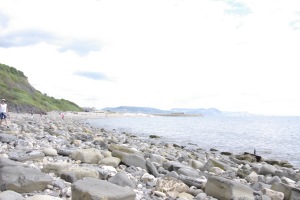Our trip might have been to Devon, but when I mapped and realised we were but an hour from Lyme Regis in Dorset, so I insisted we go. I will say that even though I wanted to go see the Cobb, Lyme did have something for all of us!
Lyme is first mentioned in historical documents in 774 as well as the Domesday book, but it wasn’t until 1284 that it received its royal charter and became Lyme Regis. At the time, the small artificial harbour, called the Cobb, was the reason for Lyme’s existence. The Cobb helps form the harbour as well as functions as a barrier protecting Lyme from damage from southwesterly gales. Around 1780, Lyme was a larger port than Liverpool!
Of course, any of us who are fans of Jane Austen remember that Louisa Musgrove fell from the Cobb in Persuasion. Jane Austen visited Lyme in 1804 and it must have made quite the impression as she used it in Persuasion and Northanger Abbey. If you’ve read her letters, you’ve no doubt read of the time she spent in Lyme and know of the influence it had on her.
Another fun fact about Lyme is it is on what is called the “Jurassic Coast” of England, which is 95 miles of shoreline between Exmouth in East Devon and Studland Bay in Dorset. The views are amazing and not only that, but it’s 185 million years (Jurassic, Triassic, and Cretaceous period) worth of fossils. You can’t remove anything large, and that’s a wonderful thing as there are some truly wonderful fossils that remain as a result. It is no wonder that this coastline is a World Heritage Site.
So, what is it like to visit Lyme! Considering how packed the beach was, parking was not a trial. We came first thing in the morning, though, and there were a lot of people parking at the same time we were. I will say that the car park was not expensive (It’s a pay and display), and was cheaper than the Park and Ride we noticed driving in.
From the car park, we followed the crowd down the hill to the coast. We travelled in early August and it was definitely touristy! I would love to go again in the off-season to get pictures when everything isn’t so crowded! The sandy beach was packed, but we really didn’t travel to Lyme for the sandy beach.
- Packed!
- The Cobb
- The Cobb
We walked the Cobb first. The children loved going up and down the steps, including the “Granny’s Teeth,” which are the crazy barely there steps where Louisa Musgrove took her fall. That didn’t make me nervous at all! (Can you hear the sarcasm there!)
After walking the Cobb, we went down the shale beach until we started seeing fossils. Some are not very distinct and there are a lot on one rock, or you might have one that is very pronounced and on an enormous rock. We probably spent close to an hour or two fossil hunting and taking photos of our favourite before we walked back.
- Ammonite!
- Layla was very impressed with the fossil
- Looking back on the Cobb
We ate outdoors at one of the pubs near the Cobb. My daughter wanted to go onto the sand beach for a bit, so we made our way through everyone on their blankets so she could dip her toes and walked through the town and back uphill to our car so we could make the hour-long drive back to Devon.
I will say that if you’re in the area, Lyme is a must see for so many reasons! The town is quaint, the coastline is beautiful, and I enjoyed Lyme thoroughly!
Next up… Saltram!
Sources:
http://www.historic-uk.com/HistoryMagazine/DestinationsUK/Lyme-Regis/
http://jurassiccoast.org/about/what-is-the-jurassic-coast/









Thank you so much Leslie. Seeing this through your eyes is helping me be there vicariously. I am hoping to actually get there one day.
LikeLike
I’m so sorry to be just now answering this! I’m so glad you enjoyed the post. If you ever get the chance, go! You’ll love it. thanks, deborahanne!
LikeLike
That was interesting to read and I did know about the fossils. We have some here in Pennsylvania as the ice glaciers pushed into our state and ended here. I picked up and kept a trilobite (this invertebrate that lived in Pennsylvania more than 250 million years ago . Related to crabs, lobsters, shrimp, spiders, and insects, trilobite is a common fossil found in many of the early to middle Paleozoic rocks of central Pennsylvania.) while on a trip with our HS science teacher. I donated it to the high school.
The photos were particularly interesting and lovely.
LikeLike